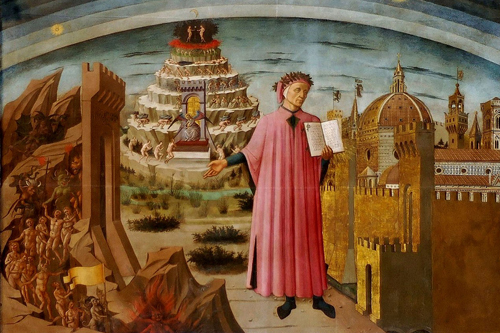How I discovered Dante

Dante at entrance to hell: The famous fresco at the Santa Maria del Fiore in Florence
Of all the cities I’ve visited, Florence is my favourite. I’ve been there only once, way back in the mid-70s. But I fell in love with it instantly. The old city – with its rabbit warren of narrow streets and passages, churches, museums, shops, and restaurants, not to mention the River Arno flowing nonchalantly under the famed Ponte Vecchio – is so picturesque that the moment you step into it, you enter a state of heightened consciousness.
The feeling of wonder and excitement that the splendour of Florence produces is so strong that it is almost palpable. After all, it was in Florence that the Renaissance in art and architecture began in the 15th Century and spread to the rest of Europe. I have a clear recollection of climbing a hill and gazing down at the city and telling myself: Wow, this is where it all began! I never imagined that one day I would be visiting the birthplace of the Renaissance and immersing myself in its charming ambience.
During that time (15th and 16th centuries), Florence was ruled by the House of Medici, a powerful and wealthy banking family and political dynasty, which poured money into the arts and sciences. One of the early Renaissance painters sponsored by this dynasty (there were several others too) was Sandro Botticelli, who produced many great works of art, including The Birth of Venus and Primavera (both are housed in the Uffizi Gallery.) Botticelli was born and bred in Florence and spent most of his life there. Florence was as much a part of Botticelli as Botticelli was of Florence.
The author that Botticelli admired most was the poet Dante Alighieri, who lived about 200 years before him. He too was a Florentine whose love for his native city was perhaps even greater than Botticelli’s. But unlike Botticelli, Dante went into politics and was banished from Florence by his enemies. The mental anguish and emotional trauma he experienced nearly drove him over the edge.
Perhaps it was a blessing in disguise for it was in exile that he produced his greatest work – The Divine Comedy, an epic narrative poem in three interconnected parts: Inferno, Purgatorio, and Paradiso. The essence of The Divine Comedy (consisting of 100 cantos) is that to reach heaven, one must pass through hell and attain purification of the soul. And hell, as envisioned by Dante, is an utterly morbid place where one encounters all sorts of terrifying creatures (including Satan himself), who derive sadistic pleasure from subjecting those who are unfortunate to end up there to extreme forms of torture and punishment.
The Divine Comedy, when it first appeared in print, had such an impact on the people of Italy that church attendance shot up dramatically!
The poem (widely regarded as one of the greatest works of world literature) is written in the first person with the pilgrim Dante himself assuming the role of the narrator. During his epic journey of self-discovery, he is accompanied at various times by three guides: Virgil (his role model representing human reason), Beatrice (his true love representing faith and grace), and St Bernard of Clairvaux (a 12th-century Benedictine monk representing meditative mysticism). The Divine Comedy, though it explores a range of religious, historical, political and philosophical themes, is written in the vernacular. In fact Dante is credited with having unified the unwieldy Italian language into a cohesive whole and ignited the flame of the Italian Renaissance in literature in the 14th century.
The Divine Comedy, which has inspired a huge number of writers, artists, and intellectuals, is one of the most widely read books of all time. Botticelli was so captivated by the poem that he produced an illustrated version of it in the form of 92 drawings. Perhaps the most famous of these is the Map of Hell (La Mappa dell’Inferno) which figures prominently in Dan Brown’s gripping novel, Inferno.
So, how did I discover Dante? Well, prior to visiting Florence I was familiar with the great Renaissance artists – Botticelli, da Vinci, Michelangelo, Raphael, Bellini, Gorgione, and Titian, to name a few – and was thrilled to see some of their works displayed in the various art galleries, including the Uffizi and the Accademia. The zenith of my short visit was seeing Michelangelo’s celebrated sculpture David in the Accademia. The emotional high I experienced upon encountering this masterpiece was identical to what I felt upon encountering his equally famous sculpture La Pieta in St Peter’s Basilica, Rome, a couple of days earlier.
My final stop was the Florence Cathedral, Santa Maria del Fiore, and this was where I discovered Dante, vis-à-vis a fresco by Domenico di Michelino (a Renaissance artist) of the author holding a copy of his epic poem and standing at the entrance to hell. Dante was new to me and so was his tour de force.
Upon returning to Toronto (where I was studying at the time), the first thing I did was to buy a copy of The Divine Comedy and read it from cover to cover over a period of several months. What astonished me was the power of Dante’s imagination, the depth of his intellect, and his ability to create a major work of fiction in verse form that holds the reader’s attention door to door. Ironically, The Divine Comedy is anything but comic for it is full of strange encounters and terrifying incidents! But love is the connective tissue that binds the three parts of the poem together. One might call it the overarching theme.
(Italy is marking the 700th anniversary of Dante’s death this year with a year-long programme of events)


